Microstructure and Performance of Al-Coating on AZ31 Prepared by Pack-Cementation with Different Heating Methods
Abstract
1. Introduction
2. Experiments and Methods
2.1. Sample Preparation
2.2. Characterization and Performance Test Methods
3. Results and Discussion
3.1. Phase Analysis
3.2. Microstructure Characteristics
3.3. Formation of the Al–Mg Coatings
3.4. Performance
3.4.1. Microhardness
3.4.2. Polarization Test
4. Conclusions
- Both aluminized layers are relatively flat and dense, and no obvious second phase is observed. The coating is composed of the outermost β-Mg2Al3 layer and the γ-Mg17Al12 layer near the inner side of the substrate.
- The diffusion efficiency of IH aluminizing is significantly higher than that of the BFH, and the coating thickness of the IH sample is twice that of the BFH sample.
- Both coatings can effectively improve the surface hardness and corrosion resistance of the magnesium alloy. The hardness and corrosion resistance of the IH diffusion sample is better than that of the BFH, which is due to the content of the intermetallic compound phase.
Author Contributions
Funding
Institutional Review Board Statement
Informed Consent Statement
Data Availability Statement
Conflicts of Interest
References
- Mola, R.; Cieślik, M. Microstructure and properties of AZ31 with an Al/Si-enriched surface layer fabricated through thermochemical treatment. Surf. Coat. Technol. 2019, 374, 201–209. [Google Scholar] [CrossRef]
- Sun, A.; Sui, X.; Li, H.; Wang, Q. Interface microstructure and mechanical properties of zinc–aluminum thermal diffusion coating on AZ31 magnesium alloy. Mater. Des. 2015, 67, 280–284. [Google Scholar] [CrossRef]
- She, J.; Pan, F.S.; Guo, W.; Tang, A.T.; Gao, Z.Y.; Luo, S.Q.; Song, K.; Yu, Z.W.; Rashad, M. Effect of high Mn content on development of ultra-fine grain extruded magnesium alloy. Mater. Des. 2016, 90, 7–12. [Google Scholar] [CrossRef]
- Liu, G.D.; Xin, R.L.; Liu, F.Y.; Liu, Q. Twinning characteristic in tension of magnesium alloys and its effect on mechanical properties. Mater. Des. 2016, 107, 503–510. [Google Scholar] [CrossRef]
- Esmaily, M.; Blücher, D.B.; Svensson, J.E.; Halvarsson, M.; Johansson, L.G. New insights into the corrosion of magnesium alloys—The role of aluminum. Scr. Mater. 2016, 115, 91–95. [Google Scholar] [CrossRef]
- Doja, S.; Bichler, L.; Fan, S. Corrosion Behavior of AZ31 Magnesium Alloy in Highly Alkaline Environment. Acta Metall. Sin. Engl. Lett. 2017, 30, 367–375. [Google Scholar] [CrossRef][Green Version]
- Pezzato, L.; Lorenzetti, L.; Tonelli, L.; Bragaggia, G.; Dabalà, M.; Martini, C.; Brunelli, K. Effect of SiC and borosilicate glass particles on the corrosion and tribological behavior of AZ91D magnesium alloy after PEO process. Surf. Coat. Technol. 2021, 428, 127901. [Google Scholar] [CrossRef]
- Chen, W.; Huang, J.; Peng, J. Characterisation of TiAlN PVD coatings on AZ31 magnesium alloy. Res. Chem. Intermed. 2015, 41, 1257–1266. [Google Scholar] [CrossRef]
- Jonda, E.; Atka, L.; Pakiea, W. Microstructure and Selected Properties of Cr3C2–NiCr Coatings Obtained by HVOF on Magnesium Alloy Substrates. Materials 2020, 13, 2775. [Google Scholar] [CrossRef]
- Zhou, X.H.; Chen, Q.R.; Wei, Z.L.; Yang, L.; Huang, Y.W. Chemical conversion coatings for magnesium alloys. Corros. Prot. 2004, 25, 468–482. [Google Scholar] [CrossRef]
- Yoon, S.; Kang, D.; Kim, J. Laser Surface Treatment of Magnesium Alloy using ZrO for Corrosion Resistance. J. Korean Soc. Manuf. Process Eng. 2016, 15, 93–100. [Google Scholar]
- Hu, J.J.; Zhang, Y.Q.; Yang, X.; Li, H.; Xu, H.B.; Ma, C.P.; Dong, Q.S.; Guo, N.; Yao, Z.W. Effect of pack-chromizing temperature on microstructure and performance of AISI 5140 steel with Cr-coatings. Surf. Coat. Technol. 2018, 344, 656–663. [Google Scholar] [CrossRef]
- Jiang, J.; Hu, J.J.; Yang, X.; Guo, N.; Xu, H.B.; Li, H.; Jin, Y.; Yu, H.B. Microstructure and annealing behavior of Cr-coatings deposited by double glow plasma on AISI 5140 steel. Results Phys. 2019, 15, 102674. [Google Scholar] [CrossRef]
- Ma, Y.P.; Li, J.; Zhu, J.; Yang, L.; Liu, Y.G.; Li, Z.Y.; Zhao, F. Effects of treatment time on corrosion of diffusion-alloyed coatings of pure magnesium. Acta Metall. Sin. Engl. Lett. 2007, 20, 72–78. [Google Scholar] [CrossRef]
- Mola, R. The properties of Mg protected by Al- and Al/Zn-enriched layers containing intermetallic phases. J. Mater. Res. 2015, 30, 3682–3691. [Google Scholar] [CrossRef]
- Zandrahimi, M.; Vatandoost, J.; Ebrahimifar, H. Pack Cementation Coatings for High-Temperature Oxidation Resistance of AISI 304 Stainless Steel. J. Mater. Eng. Perform. 2012, 21, 2074–2079. [Google Scholar] [CrossRef]
- Nassif, N.; Ghayad, I. Corrosion Protection and Surface Treatment of Magnesium Alloys Used for Orthopedic Applications. Adv. Mater. Sci. Eng. 2013, 2013, 346–349. [Google Scholar] [CrossRef]
- Calderón, D.; Galindez, Y.; Toro, L.; Zuleta, A.A.; Echeverría, F. Intermetallic-Rich Layer Formation for Improving Corrosion Resistance of Magnesium Alloys. Met. Mater. Int. 2021, 28, 657–665. [Google Scholar] [CrossRef]
- Shigematsu, I.; Nakamura, M.; Saitou, N.; Shimojima, K. Surface treatment of AZ91D magnesium alloy by aluminum diffusion coating. J. Mater. Sci. Lett. 2000, 19, 473–475. [Google Scholar] [CrossRef]
- Le, J.J.; Liu, L.; Liu, F.; Deng, Y.D.; Zhong, C.; Hu, W.B. Interdiffusion kinetics of the intermetallic coatings on AZ91D magnesium alloy formed in molten salts at lower temperatures. J. Alloy. Compd. 2014, 610, 173–179. [Google Scholar] [CrossRef]
- Zhong, C.; He, M.F.; Liu, L.; Chen, Y.J.; Shen, B.; Wu, Y.T.; Deng, Y.D.; Hu, W.B. Formation of an aluminum-alloyed coating on AZ91D magnesium alloy in molten salts at lower temperature. Surf. Coat. Technol. 2010, 205, 2412–2418. [Google Scholar] [CrossRef]
- Lu, D.; Zhang, Q.; Wang, W.; Guan, F.; Ma, X.; Yang, L.; Wang, X.; Huang, Y.; Hou, B. Effect of cooling rate and the original matrix on the thermal diffusion alloyed intermetallic layer on magnesium alloys. Mater. Des. 2017, 120, 75–82. [Google Scholar] [CrossRef]
- Schmitz, G.; Kruse, B.; Baither, D.; Kim, T.H. Concentration Characteristics of Diffusion-Induced Recrystallization. Defect Diffus. Forum 2009, 289–292, 719–724. [Google Scholar] [CrossRef]
- Okamoto, H. Supplemental Literature Review of Binary Phase Diagrams: Al-Mg, Bi-Sr, Ce-Cu, Co-Nd, Cu-Nd, Dy-Pb, Fe-Nb, Nd-Pb, Pb-Pr, Pb-Tb, Pd-Sb, and Si-W. J. Phase Equilibria Diffus. 2015, 36, 183–195. [Google Scholar] [CrossRef]
- Yang, H.; Guo, X.; Wu, G.; Wang, S.; Ding, W. Continuous intermetallic compounds coatings on AZ91D Mg alloy fabricated by diffusion reaction of Mg–Al couples. Surf. Coat. Technol. 2011, 205, 2907–2913. [Google Scholar] [CrossRef]
- Hu, J.J.; Zeng, J.; Yang, Y.; Li, H.; Guo, N. Microstructures and Wear Resistance of Boron-Chromium Duplex-Alloyed Coatings Prepared by a Two-Step Pack Cementation Process. Coatings 2019, 9, 529. [Google Scholar] [CrossRef]
- Takesue, S.; Kikuchi, S.; Misaka, Y.; Morita, T.; Komotori, J. Rapid nitriding mechanism of titanium alloy by gas blow induction heating. Surf. Coat. Technol. 2020, 399, 126160. [Google Scholar] [CrossRef]
- Shen, M.; Zhu, S.; Wang, F. A general strategy for the ultrafast surface modification of metals. Nat. Commun. 2016, 7, 13797. [Google Scholar] [CrossRef]
- Huang, W.M.; Xia, X.Y.; Liu, B.; Liu, Y.; Wang, H.W.; Ma, N.H. Electrodeposition of aluminum on aluminum surface from molten salt. Acta Metall. Sin. Engl. Lett. 2011, 24, 443–448. [Google Scholar]
- Li, X.; Liang, W.; Zhao, X.; Zhang, Y.; Liu, F. Bonding of Mg and Al with Mg–Al eutectic alloy and its application in aluminum coating on magnesium. J. Alloys Compd. 2009, 471, 408–411. [Google Scholar]
- Liu, F.; Meng, Q.; Li, Z. Microstructure and properties of alloying coating on AZ31B magnesium alloy. Trans. Nonferrous Met. Soc. China 2016, 26, 2347–2354. [Google Scholar] [CrossRef]
- Zhu, L.; Song, G. Improved corrosion resistance of AZ91D magnesium alloy by an aluminium-alloyed coating. Surf. Coat. Technol. 2006, 200, 2834–2840. [Google Scholar] [CrossRef]
- Liu, W.X.; Li, X.L.; Zhou, X.J. Formation Mechanism of Al and Zn Coating by Solid Diffusion on AZ81 Magnesium Alloy Surface. Surf. Technol. 2018, 47, 36–41. [Google Scholar]
- Hu, J.J.; Liao, J.; Yang, X.; Zeng, J.; Li, H.; Song, B.; Xu, H.B.; Guo, N.; Jin, Y. Microstructure and properties of Al-coating on AZ31 magnesium alloy prepared by pack-cementation. Trans. Nonferrous Met. Soc. China 2022, 32, 493–502. [Google Scholar] [CrossRef]
- Khara, S.; Choudhary, S.; Sangal, S.; Mondal, K. Corrosion resistant Cr-coating on mild steel by powder roll bonding. Surf. Coat. Technol. 2016, 296, 203–210. [Google Scholar] [CrossRef]
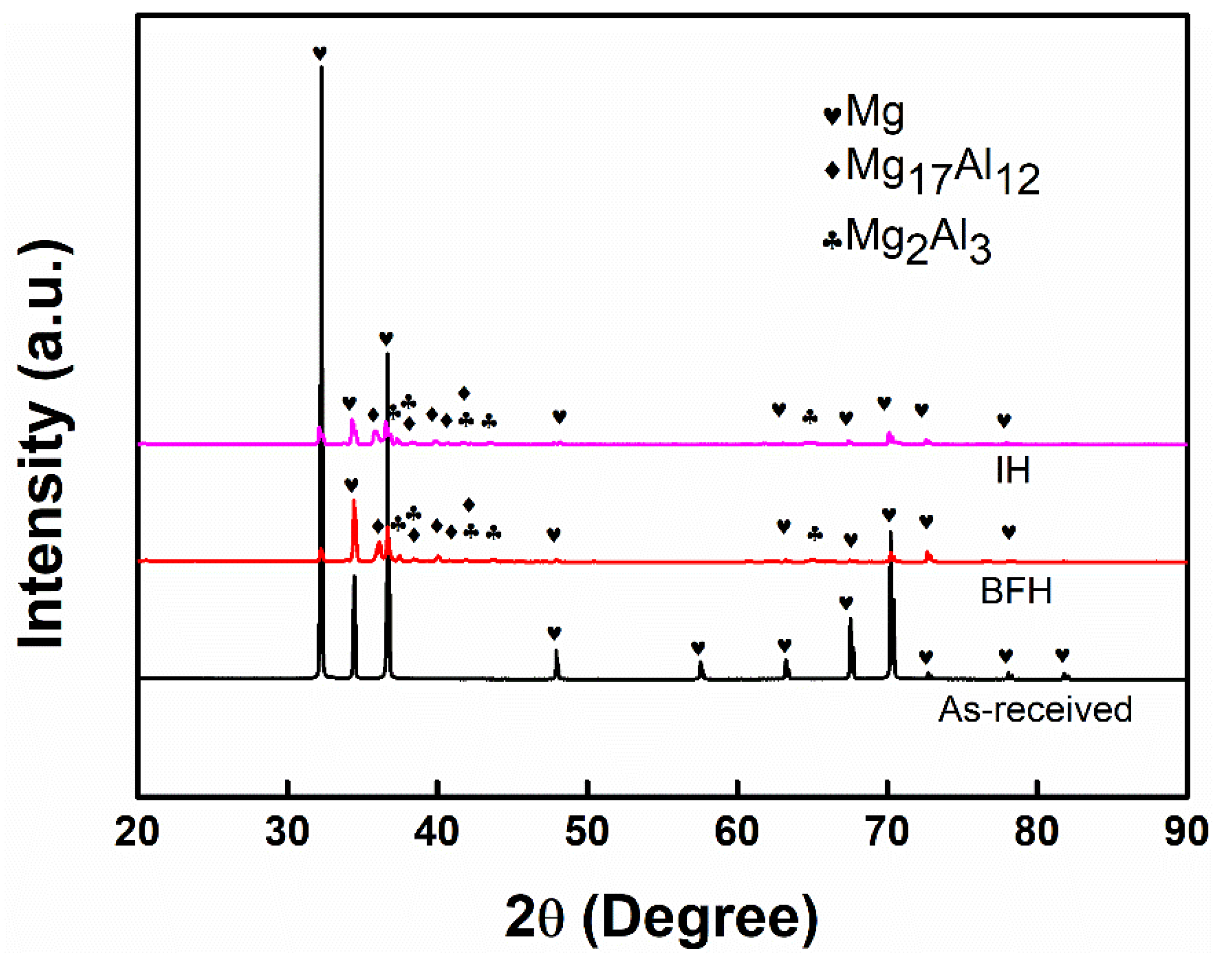
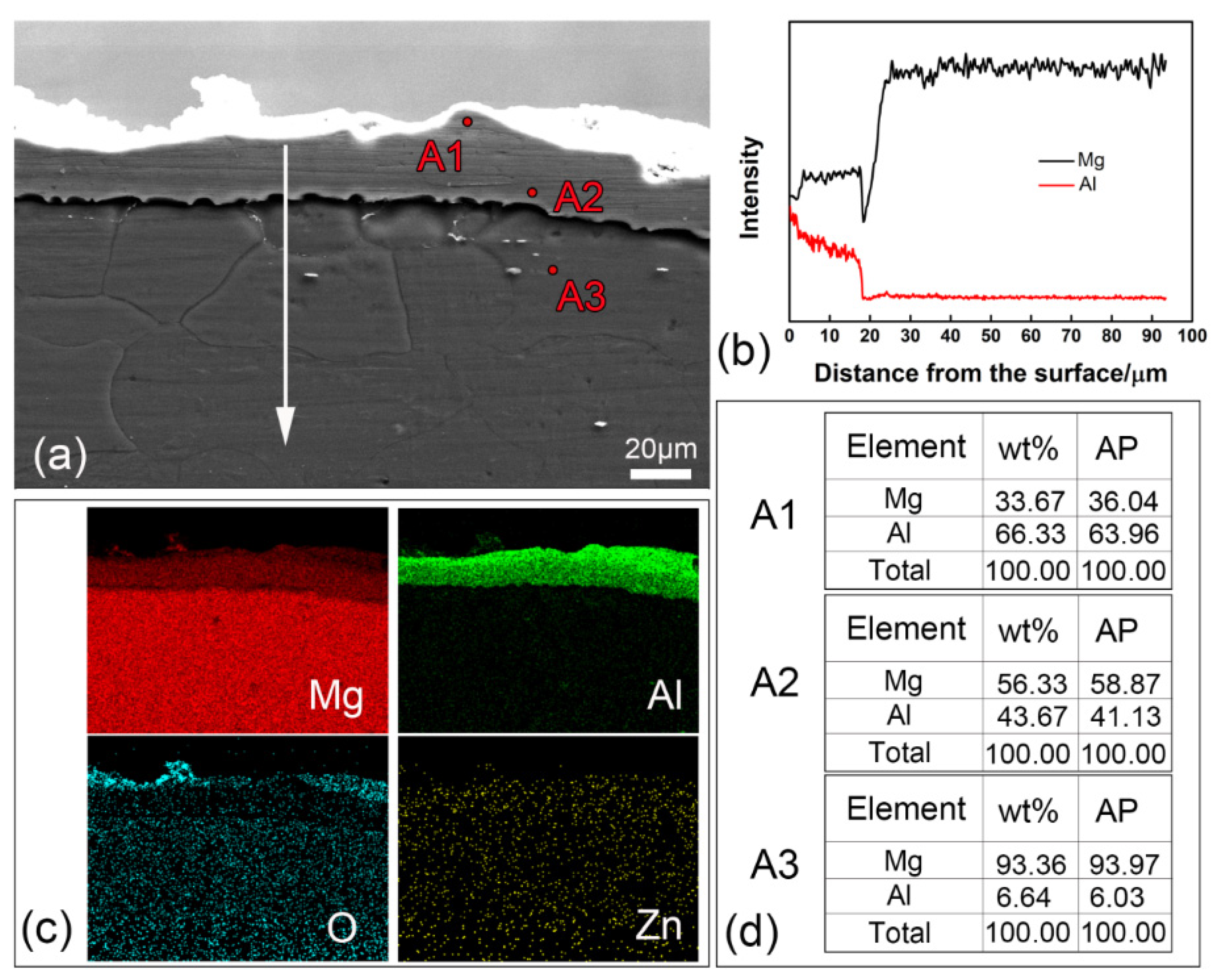

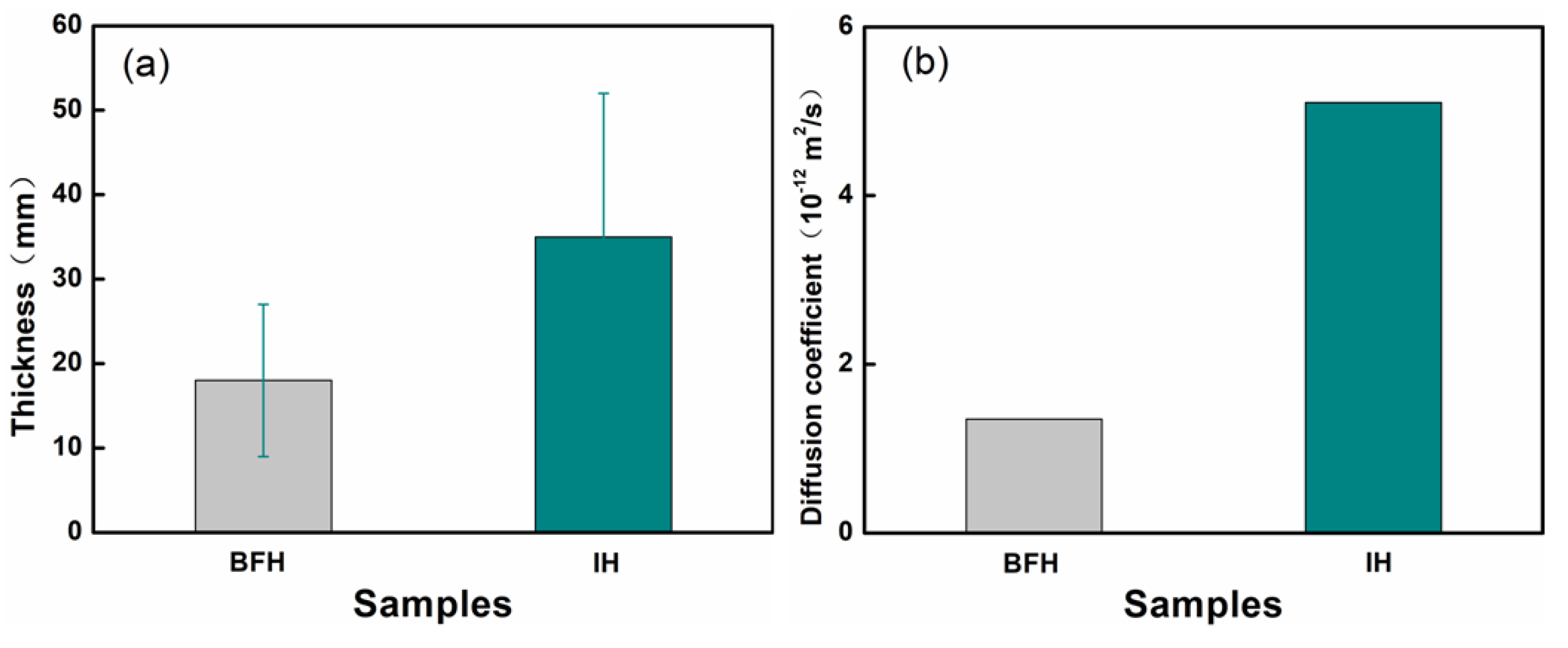

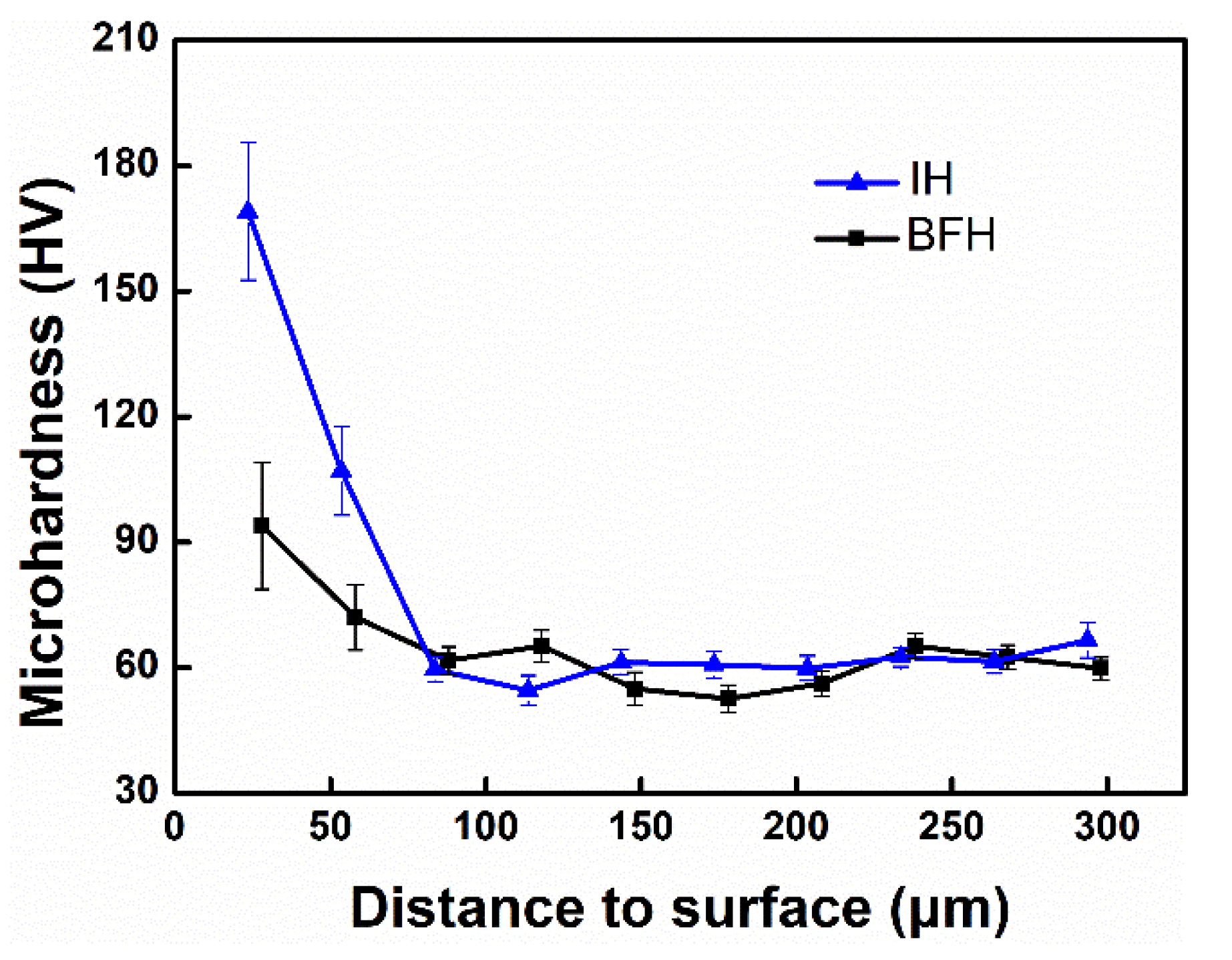
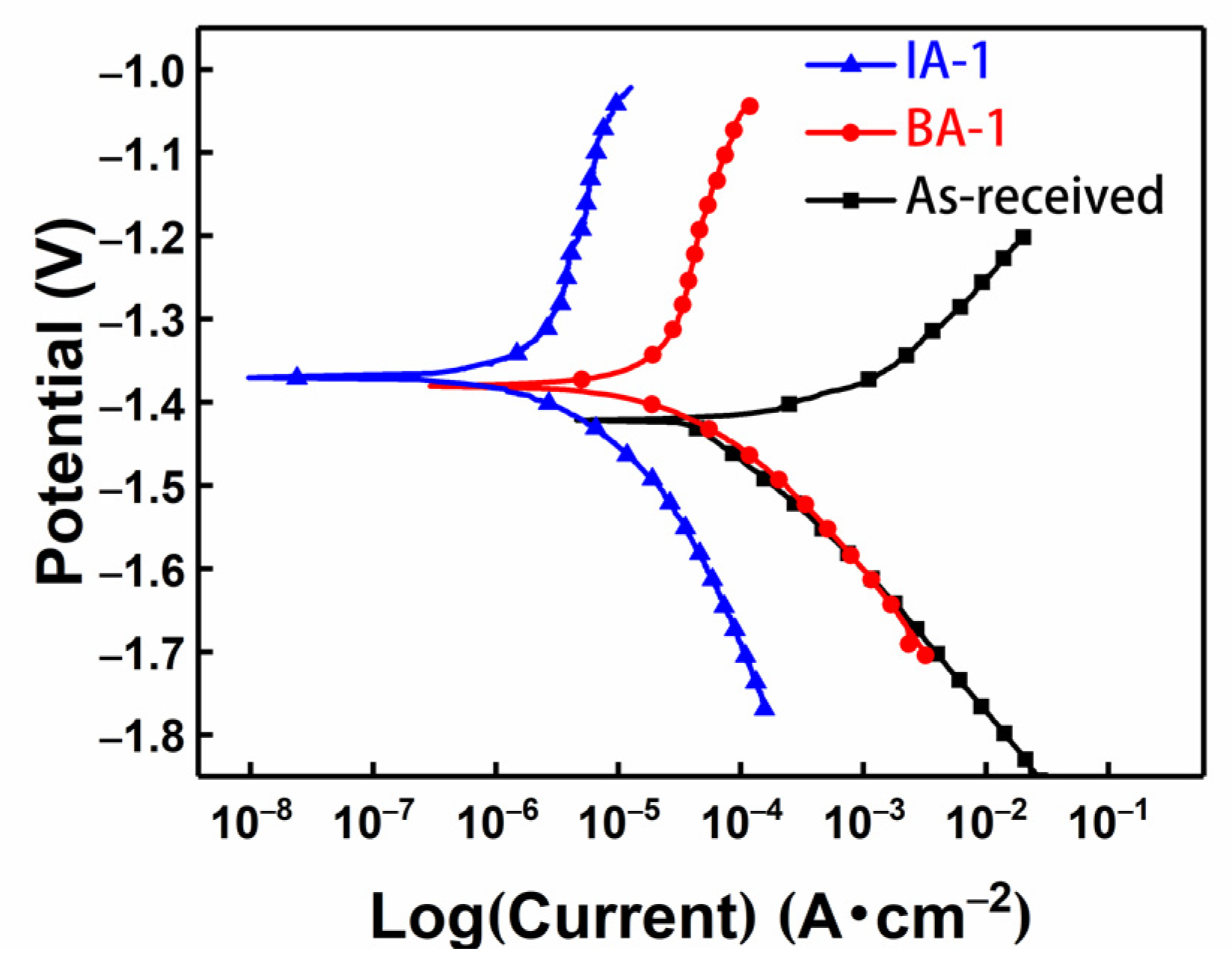
| Samples | Ecorr (v) | Icorr (A/cm2) | CR (mm/y) |
|---|---|---|---|
| As-received | −1.42 | 2.63 × 10−4 | 5.7654 |
| IH | −1.37 | 6.00 × 10−6 | 0.1315 |
| BHF | −1.38 | 4.24 × 10−5 | 0.9689 |
Publisher’s Note: MDPI stays neutral with regard to jurisdictional claims in published maps and institutional affiliations. |
© 2022 by the authors. Licensee MDPI, Basel, Switzerland. This article is an open access article distributed under the terms and conditions of the Creative Commons Attribution (CC BY) license (https://creativecommons.org/licenses/by/4.0/).
Share and Cite
Yang, X.; Liao, J.; Hu, J.; Hou, X.; Li, H.; Song, X.; Jiang, P.; Guo, N. Microstructure and Performance of Al-Coating on AZ31 Prepared by Pack-Cementation with Different Heating Methods. Metals 2022, 12, 809. https://doi.org/10.3390/met12050809
Yang X, Liao J, Hu J, Hou X, Li H, Song X, Jiang P, Guo N. Microstructure and Performance of Al-Coating on AZ31 Prepared by Pack-Cementation with Different Heating Methods. Metals. 2022; 12(5):809. https://doi.org/10.3390/met12050809
Chicago/Turabian StyleYang, Xian, Jing Liao, Jianjun Hu, Xiang Hou, Hui Li, Xule Song, Peng Jiang, and Ning Guo. 2022. "Microstructure and Performance of Al-Coating on AZ31 Prepared by Pack-Cementation with Different Heating Methods" Metals 12, no. 5: 809. https://doi.org/10.3390/met12050809
APA StyleYang, X., Liao, J., Hu, J., Hou, X., Li, H., Song, X., Jiang, P., & Guo, N. (2022). Microstructure and Performance of Al-Coating on AZ31 Prepared by Pack-Cementation with Different Heating Methods. Metals, 12(5), 809. https://doi.org/10.3390/met12050809







